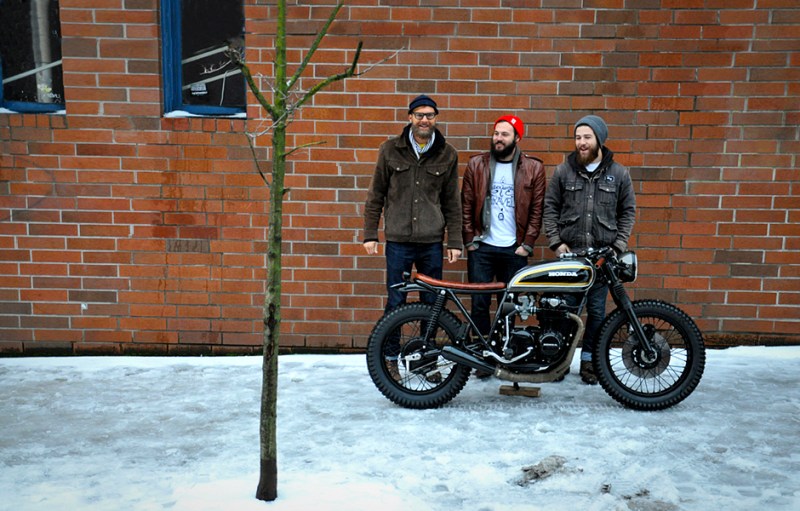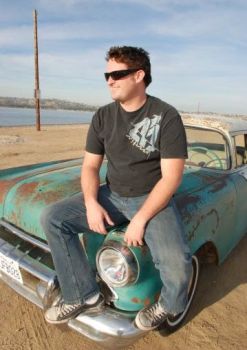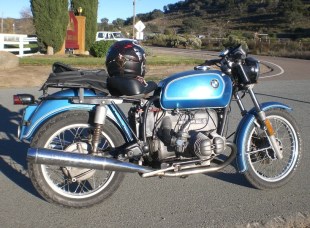
(Pictured above, from left to right: Seaweed & Gravel owner David Patri (not interviewed), Brady Young, and Jarred DeArmas)
The Manual: How did you get started building motorcycles?

Evan Grist (pictured left): While I’ve built plenty of my own bikes, and designed and performed countless modifications for customers, I don’t really ‘build’ motorcycles. I’m an electrical engineer, and I focus on designing and developing electrical parts for motorcycles. I specialize on motorcycle charging and ignition systems, custom wiring harnesses, and gauges/meters/computers, switches and lights. I got my start in motorcycles when I was 21, with a $300 Craigslist special 1974 Suzuki TS125. After my first ride and crash on this bike in the desert trails East of San Diego, I was hooked for life on not only riding, but fixing, customizing and improving my bikes.
Brady Young: What started it was a run down ’71 Yamaha CT175. It was my good friend’s brother’s first dirt bike, and abandoned after he got a new one. What started as an innocent chop and see what happens idea quickly escalated into an everyday-after-work project. We sourced an XS650 motor and managed to squeeze it into the tiny frame, little by little building a new frame around it. Long story short, it was a wonderful failure. But I had lost my virginity and made enough mistakes needed to get me going in the right direction.
Jarred DeArmas: … I had always liked motorcycles as a kid, but my parents wouldn’t let me ride one, so I decided that if I bought an old Honda that obviously wasn’t running, with the intent to fix it up and make it run, that would be ok with my parents … it wasn’t. Haha. But they let me get a scooter. I was super into cafe bikes, and on my next tour with the band, I browsed Craigslist in every state looking for the perfect buy. I found a 1976 CB550 in Sacramento on the third-to-last day of tour and bought it for 300 bucks. I threw it in the trailer and brought it home and worked on it in my friend’s garage. I ended up telling my parents, and once they realized I was really into it and that the bike probably would never run, they were cool with it.
If you had to pick one stock bike to ride for the rest of your life, which would you choose?
EG: This is a tough question! I’ve owned almost 40 motorcycles in the last 10 years. At this point, I’ve put a lot of miles on just about every type of bike. I always keep going back to 70’s BMW airheads. I’ve had a couple R90 /6 and R100 /7. My last 1974 BWM R90 /6 was my favorite, and was a nicely modified bike with a great patina. This would be my pick for a stock bike that I could happily put miles on for years. They have decent power, handle fairly well, and just look damn cool. They are rock solid reliable, low maintenance costs, and just plain fun.
BY: I’d have to say a Harley Shovelhead FLH, for a few reasons. I’ve always been a sucker for a shovel, when my back goes I can still ride, and when I’m old my grandkids will still think I’m cool.
JD: Honda CB750F.
How did you first get the notion to do the Motorbike Mondays podcast?
EG: I met Jarred and Brady last year, when they called RaceTech Electric for a charging rotor and voltage regulator for a DOHC CB750 build they were working on. My shop is about 15 minutes from theirs, so they headed over to pick up the parts. The three of us hit it off, and started helping each other out on projects we had going on. While wrenching at the Seaweed & Gravel shop late one night adapting a Honda CB voltage regulator to Jarred’s Yamaha TX500 build, the topic of starting a motorcycle podcast came up (Brady’s idea I think). I had some experience running a podcast (reviewing parties at San Diego State!) and can talk about motorcycles all day, so I was interested. I pulled together some of my band’s old mic’s & mixing equipment, and we started recording.
BY: I get a lot emails people asking questions and advice on projects that they are working on, but can’t give my full attention to them as much as I would like. So Jarred, Evan, and myself thought not only would the podcast be a good resource for people and help them out, but a good excuse to hang out with buds and chat about what we’re all passionate about. We all started somewhere and need advice or guidance along the way.
JD: It was Brady’s idea, and I thought it was cool, so we wanted to give it a shot and see how it went. We told Evan we were thinking about it, and he was down to join, so we got together and recorded a few episodes. I think it’s getting a pretty good response overall.
If I wanted to create a custom bike for as cheaply and as easily as possible, which make and model would you suggest I buy to get a badass end result?

EG: There’s tons of bikes to start with. I think the vision, effort, details, and choice of parts/mods contributes more to a killer finished product than the particular make/model you start with. However, we talk a lot about 70’s Japanese bikes on the podcast. Specifically, you can’t go wrong with a SOHC (Single Over Head Cam) 1970’s Honda CB (CB550 & CB750 are the most popular/common), 1970’s Yamaha XS650 twin, 1970’s BMW R-series Airhead, or 1970’s-1980’s Suzuki GS model.
BY: Anything you can get your hands on, or what you’re willing to tackle. If it has a free motor, chances are it won’t cost much to get it running. As far as the badass result, I’ll put $5 on the table that, after you make it your own and put the needed time into it, you’ll pull up to the dude on a West Coast Chopper and think he’s a sucker. Just make sure it’s safe.
JD: I would recommend any mid 70’s CB350-750. Whichever you can get for the best deal with a motor that is free would be, in my opinion, your best bet.
Seaweed & Gravel embodies far more than just custom bikes – its an entire lifestyle filled with badass bikes, beautiful women, and awesome clothes. Is that just a front, or are your lives really that awesome?
EG: The Seaweed & Gravel lifestyle of rad bikes, hot chicks, and cool clothes is super accurate. That’s really what we all had in common that got us all together. Ha! I think, if you’re really into bikes, specifically older bikes and custom builds, the rest kind of follows. It’s not that all the bikes are awesome, and all the girls are beautiful; it’s just that you tend to find the same kind of people to spend time with that share your interests and style. In reality, we spend most of our time with greasy hands, wrenching on bikes, welding, soldering, and working. To me, that’s an awesome life! I didn’t realize anybody on the Internet might have thought I was cool, and I hate to ruin the show, but it’s probably just a front!
BY: Haha. At Seaweed & Gravel, we do feel very blessed to be able to do what we love, and spend it with some really genuine people. We don’t always share waiting line at the DMV or coming home to dog sh*t on the floor. We’re just a bunch of weirdos trying to have fun.
JD: I’m very happy with my life. I’ve got a beautiful girl, a dog, and we just moved into a new house. We have our own shop for building bikes, which is something I never dreamed of. And I build bikes because I love to, and I make a little money on it. I think Seaweed just sands for a positive, happy lifestyle, and that’s why it works so well.
Ed. note: This interview has been lightly edited for length.


